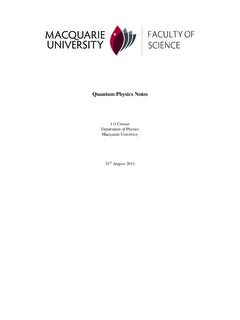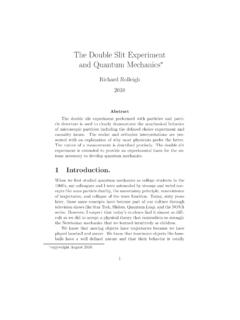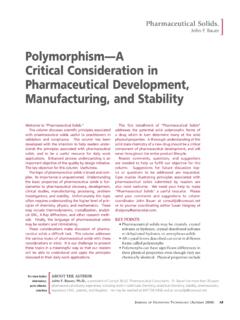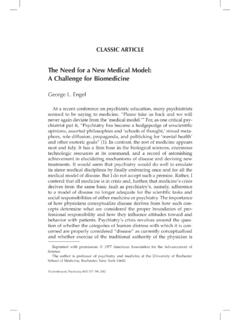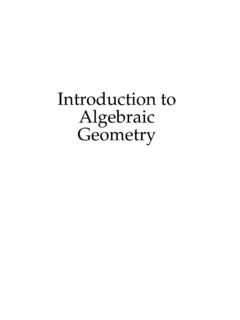Transcription of The Pythagorean Philosophy of Numbers
1 The Pythagorean Philosophy of Numbers Silvano Leonessi, adapted by Mary Jones, ythagorean thought deeply influenced P Greek Philosophy . Aristotle dedicated a portion of his Metaphysics to the subject of the Philosophy of Numbers , and this recalled the Pythagorean approach to Numbers and their meaning. In his work Metaphysics (ca. 350 BCE), Aristotle proposed three questions: What is existence, and what sorts of things exist in the world? How can things continue to exist, and yet undergo the change we see about us in the natural world? And, thirdly, how can we understand this world? He wrote in response to the first two questions on existence and being: ..the so-called Pythagoreans, who were the first to take up mathematics, not only advanced this study, but also having been brought up in it they thought its principles Portrait of Aristotle.
2 Marble, Imperial Period, first or were the principles of all things. Since of these second century. Copy of a lost bronze sculpture made principles Numbers are by nature the first, by Lysippos. Louvre, Paris. Photo 2005 by Eric Gaba/. and in Numbers they seemed to see many Wikimedia Commons. resemblances to the things that exist and supposed the elements of Numbers to be the come into being more than in fire and earth elements of all things, and the whole heaven and water (such and such a modification to be a musical scale and a number . And all of Numbers being justice [for example], the properties of Numbers and scales which another being soul and reason, another being they could show to agree with the attributes similarly almost all other and parts and the whole arrangement of the things being numerically expressible).
3 Heavens, they collected and fitted into their He continues to expand on the third scheme; and if there was a gap anywhere, they question on understanding nature: readily made additions so as to make their ..since again, they [the Pythagoreans] whole theory coherent. 1. saw that the modifications and the ratios It is clear that they conceived number as of the musical scales were expressible in the first principle (Greek: Arch ), and that the Numbers ; since then, all other things seemed substance of the entire universe is identified in their whole nature to be modeled on with Numbers . number is conceived not as Numbers , and Numbers seemed to be the a mental abstraction but something which first things in the whole of nature, they exists in and composes all things. Philolaos of Page xix Nowadays, we think of number as a sign to denote a specific amount or quantity.
4 We use Numbers as tokens to represent things. The Pythagoreans saw number as a universal principle, such as light or electromagnetism or sound. As modern physics has demonstrated, it is precisely the numeric, vibrational frequency or wavelength of electromagnetic energy that determines its particular manifestation. Two Principles According to Aristotle, the Pythagoreans traced the origin of all things back to two principles: the even and the odd. He wrote: Evidently then, these thinkers also consider that number is the principle both as matter for things and as forming both their Iamblichus of Chalchis, Assyrian Neoplatonic modifications and their permanent states, Philosopher and Neopythagorean. and hold that the elements of number are the even and the odd, and that of these, the latter Tarentum (ca.)
5 475 BCE), in his book on is limited, and the former unlimited; and that Pythagorean Numbers states: All things, at the One proceeds from both of these (for it least those we know, contain number ; for it is both even and odd), and number from the is evident that nothing whatever can either be One; and that the whole heaven, as has been thought or known without number . said, is Numbers . 2. The Neoplatonist Iamblichus reinforced this when he stated that the causal approach to nature consisted in positing mathematical things as causes from which the objects in the perceptible world arise. He subscribed to the Pythagorean belief that only what was possible in mathematics was possible in the structure of nature, and that nothing could exist that implied a mathematical impossibility. These are advanced thoughts for such an early era in our history.
6 number Philosophy A metaphysical Philosophy lay at the heart of Pythagoras's thought and teachings. His understanding of Numbers was quite different from the understanding of today. To Pythagoras and his followers, the idea of number was a living, qualitative reality that Rosicrucian had to be experienced. To them, it was not Harm Kamerlingh Onnes, Einstein's Portrait, 1920. Painted Digest on the occasion of Einstein becoming extraordinary No. 1 something to be used, but rather something professor at the University of Leiden. Academic Historic 2009 whose nature was to be discovered. Museum Leiden. Page xx For the Pythagoreans, the elements of number are the even and the odd, or the limited and the unlimited; this is because Numbers derive from the One, and the One from the even (unlimited) and the odd (limited).
7 Aristotle tells us that the Pythagoreans saw the unlimited as evil, and limited as good. It seems that they also identified the number one (the monad) The geometric figure is a number of points in space: the actual number determines the shape or object itself. with the limited, and two (the dyad) with the unlimited. The emergence of the One deductions. The strength of the foundations appears to follow the Law of the Triangle in of scientific Pythagoreanism is from the that it comes from the odd and even and itself methodological approach, rationally analyzed produces number or the whole of nature. and developed with great discipline and, at Accepting that number constitutes the the same time, transcended by a powerful essence of everything, it is overshadowed by initiatory and ontological global system.
8 The concept of a material reality quite separate and distinct from what we might consider Geometry to be a purely abstract number , and even It should be noted that mathematics and today in atomic physics laboratories, reality is geometry were considered to be intimately composed of complex numerical interactions related, since geometry necessarily requires in dealing with subatomic particles and knowledge of mathematics and since fields. Einstein says that the universe is Numbers , consisting of single points, combine number , which accords with the ancient to form geometric figures, so that we can talk Pythagorean vision. about triangular, square, rectangular, and According to Richard Feynman (1918- cubic shapes. number was considered an 1988), the discovery of the theory of relativity essential part of the Monad, and the Monad came about because of a Greco- Pythagorean was considered identical to a geometric point.
9 Mode of investigation based on the interaction A number then was a geometric figure of sets of axioms with subsequent logical and a geometric figure was a number . The geometric figure is a number of points in space: the actual number determining the shape or object itself. The concept that is the .. the discovery of basis of the Pythagorean principle that things are Numbers is therefore, a measurable one. the theory of relativity From this, we can infer that since the whole came about because of world is made of Numbers it follows that the a Greco- Pythagorean true nature of the world is a sort of geometry in Numbers and is therefore measurable. mode of investigation This allows an explanation of things such as based on the interac- the seasonal motion of the celestial bodies, tion of sets of axioms musical harmonies, the cycle of vegetation, with subsequent as well as abstract qualities and things such as justice, the intellect, and the soul.
10 Logical deductions. The properties and elements of Numbers correspond to the properties of things. So, something that seems far removed from Page xxi Pythagoreans saw number as a universal principle such as light, electromagnetism, or sound. From the Rosicrucian archives, 2009, Supreme Grand Lodge of AMORC. number is, on closer inspection, traceable For Pythagoras, mathematics was a bridge to a quantitative and measurable structure. between the visible and invisible worlds. It Simple mathematical operations like addition, was a way of understanding and working subtraction, multiplication, and division allows with nature, leading to the contemplation the search for equality and harmony in One of eternal things that never vary. By focusing and the one in multiplicity. This was of great on the elements of mathematics, one could importance to the Pythagoreans, who were calm and purify the mind and ultimately the first to measure the real and the abstract in experience true happiness.


